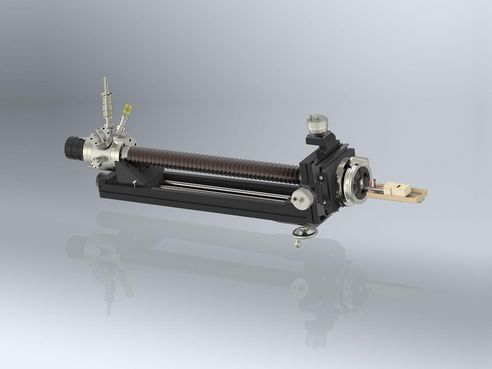 Detail
DetailO-EC-NAP Operando Electrochemical Cell
Operando Electrochemical Cell for NAP-XPS investigations of electrochemical processes at the interface between electrode and electrolyte
The O-EC-NAP cell allows for NAP-XPS measurements of electrochemical processes electrode - electrolyte interfaces. It has a three electrodes (WE, RE, CE) and is mounted on its own 4-axes manipulator. By rotating the manipulator, the area of interest for NAP-XPS measurements can be easily located. The O-EC-NAP cell can be used with or without a window. In order to minimize evaporation of the electrolyte from the investigation area during the measurements, an additional buffer cell serves as a sacrifice trough for maintaining the vapor pressure value constant during the experiments. Additionally, the buffer cell catches any spilled electrolyte and prevents that the electrolyte drops into the chamber.
The 4-axes manipulator is equipped with all electrical connection for the electrodes as well as the liquid pipelines for filling and draining the O-EC-NAP cell. A peristaltic pump is used for liquid transfer between a reservoir and the EC-cell.
The O-EC-NAP Operando Electrochemical Cell module comes with its own vacuum chamber, pumps and frame and therefore can be attached to almost any NAP-XPS system with backfilling configuration. The first delivered cell was connected to a multimethod NAP-XPS system that combines NAP-XPS, IRRAS and electrochemical investigation techniques for ultimate flexibility in the characterization of various samples and processes.
KEY FEATURES
- operando electrochemical cell for NAP-XPS measurements of liquid-solid interfaces with 3 electrodes setup: working, reference and counter electrode
- high versatility: it can be used with or without a window
- extreme flexibility: it can be attached to almost any NAP-XPS system with backfilling configuration
- in-situ refillable by using a peristaltic pump



